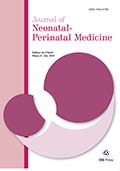Authors: Rohsiswatmo, R. | Azharry, M. | Sari, T.T. | Bahasoan, Y. | Wulandari, D.
Article Type:
Research Article
Abstract:
BACKGROUND: Late-onset neonatal sepsis (LONS) detection is problematic as no single examinations (blood culture, c-reactive protein (CRP), procalcitonin (PCT)) are reliable. Toll-like receptors (TLRs), which detect the presence of pathogen-associated molecular patterns is a promising novel biomarker, but less studied in LONS. This study aimed to determine neutrophils and monocytes TLR2 and TLR4 expression in LONS and their diagnostic value. METHODS: A cross-sectional study conducted in May and June 2017 involving 52 neonates with clinical late-onset (>72 hours of age) sepsis. We examine complete blood count, I/T ratio, CRP, PCT, as well as TLR2 and TLR4 expression to
…compared with blood culture as the gold standard. We classified cases into proven or unproven sepsis. RESULT: The incidence of LONS was 32.6% in the subjects. The expression of TLR2 was low in LONS, while TLR4 was high. TLR4 neutrophil expression has 88.2% sensitivity, 20% specificity, 34.9% positive predictive value (PPV), 77.8% negative predictive value (NPV), and an AUC of 0.541. TLR4 monocyte expression has 92.1% sensitivity, 11.4% specificity, 34% PPV, 80% NPV, and an AUC of 0.528. The AUC of CRP is increased from 0.608 to 0.843 after combination with TLR4, comparable with CRP + PCT (AUC 0.829). CONCLUSION: The increase in TLR4 expression has good sensitivity but low specificity. TLR4 expression, in combination with CRP, could become a reliable biomarker for the diagnosis of LONS.
Show more
Keywords: Late-onset neonatal sepsis, biomarker, TLR2, TLR4, procalcitonin, c-reactive protein
DOI: 10.3233/NPM-200411
Citation: Journal of Neonatal-Perinatal Medicine,
vol. 14, no. 3, pp. 361-367, 2021
Price: EUR 27.50




